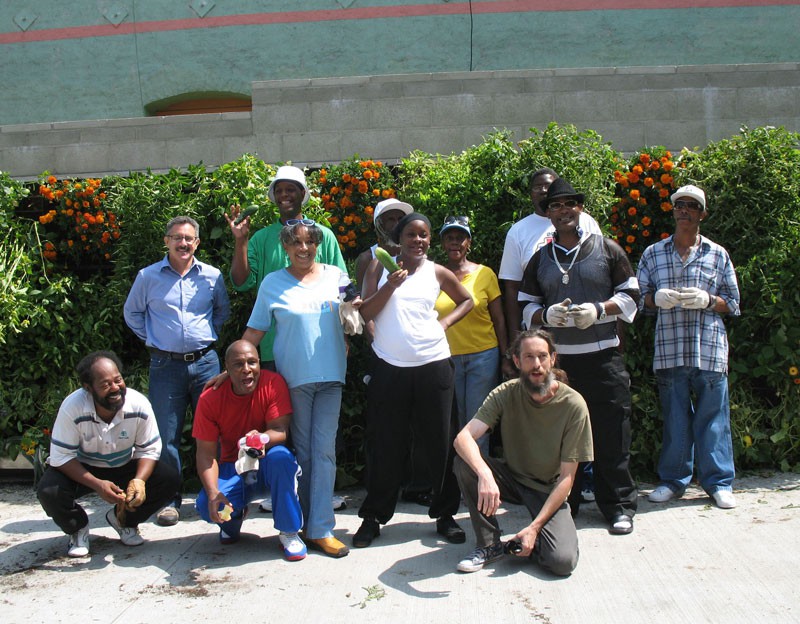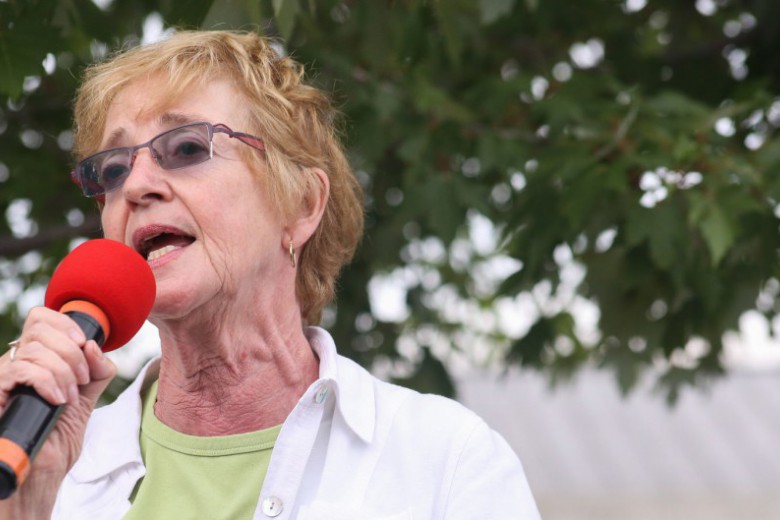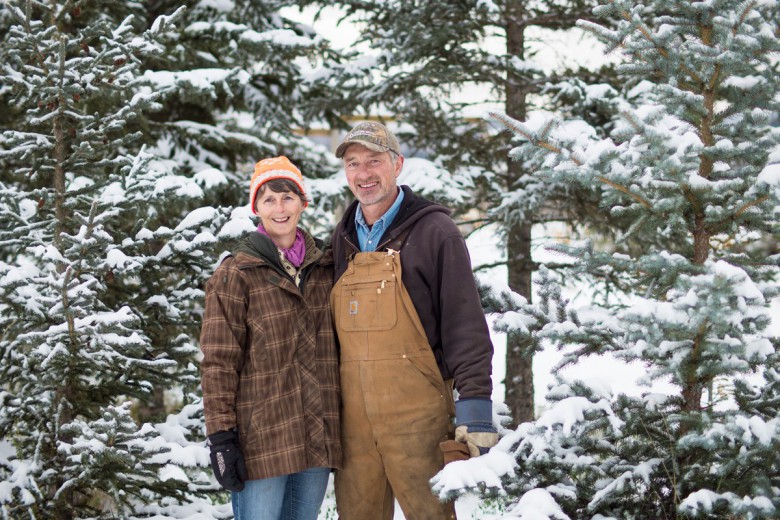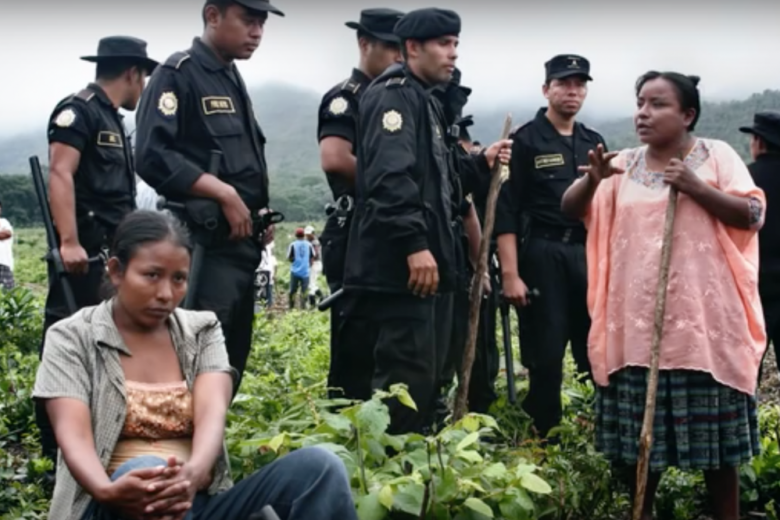
#1. Become a freegan
By Stephanie Dearing
Thank goodness for freegans, who have excelled at showing us how much food we waste every day. Freegans do for wasted food what the 100 Mile Diet has done for eating locally grown food. People who practice freeganism are also showing us how we can pinch pennies and save money in this recession.
Freegans, according to Freegan.info, “are people who employ alternative strategies for living based on limited participation in the conventional economy and minimal consumption of resources. Freegans embrace community, generosity, social concern, freedom, cooperation, and sharing in opposition to a society based on materialism, moral apathy, competition, conformity and greed.”
The word freegan is a mix of free and vegan, although you do not have to be a vegan to be a freegan. Freeganism is both a philosophy and a way of life, and it is adopted far and wide in a variety of ways by diverse people. Take Ginger, for example. She has been calling herself a freegan, but says she now wants to move away from the name because she’s realized that freegans are against things, such as capitalism. Ginger said that she’s for things, so she doesn’t identify strictly with the freegan point of view. On the other hand, Ginger has embraced one practice common to most freegans – salvaging food from dumpsters.
Ginger was inspired to become a freegan after seeing an Oprah show on February 28, 2008 that featured a segment depicting a group of people on a “trash tour,” gleaning good food from the waste stream. After seeing the show, Ginger said that she thought she would just “go and look.” And so she did, and found a cornucopia of fruits and vegetables, all perfectly good, in the dumpster.
She was hooked. Ginger said that she now regularly obtains food from grocery store dumpsters. She figures the food she obtains is worth about $600 per trip. She takes some food home, gives some to friends and neighbours, and the balance goes to homeless shelters. Ginger might not call herself a freegan, but she is engaging in the premiere freegan activity.
As Ginger noted, freegans are “against” things, most particularly the capitalist system. Freegans are horrified by the amount of waste generated by capitalist activities, so they seek to reduce their resource consumption by reclaiming food, clothing and furniture from the waste stream. Many people say that they eat better as freegans than they would if they purchased their food. Extreme freegans will not pay for things such as housing and transportation either, preferring to share a squat with other freegans while getting around by hitchhiking, walking or bicycling. Freegans in New York City have even established a free shop.
“More than half the food produced today is either lost, wasted or discarded because of inefficiency,” the United Nations Environment Program (UNEP) announced earlier this year. The UNEP points out that we could easily feed every single person in the world today if we did not waste all this food. This is borne out by Ginger’s experience. “I asked some of the grocery store staff to estimate the value of the food they throw away every day,” she said. “And they said it was at least $1,000 a day, if not more.” The Toronto Star reported last spring that households throw out an average of 210 million kilograms of food each year – and most of that food is still edible.
If you are interested in adopting some or all freegan principles you can learn more at freegan.info. Join up with a freecycle group in your area at freecycle.org to swap your perfectly good but unwanted items with other people, or post your swaps on craiglist’s swap page, craigslist.org. You can ramp things up a step further and organize a “frock swap” or book exchange, or even a “really free market.” And check out Ginger’s blog at savethefood.com.
#2. Promote bicycle transportation in your community
By Brittany Shoot
North Americans could learn much from Danish efforts to promote bicycle usage.
The idyllic stories of life in Denmark are becoming better known as Danes are increasingly dubbed “the happiest people in the world” by various North American media outlets. But in the land of wind turbines and six-week paid vacations from work, bicycle-friendly laws and lanes are among the most notable commitments to a better lifestyle. Large numbers of Danes have learned to reconceptualize transportation by relying solely on their physical strength and mental resolve to pedal to their destination – which has had the added benefit of reducing their carbon footprint.
North Americans could learn much from Danish efforts to promote bicycle usage. For decades, some of the biggest cities in the United States and Canada have struggled to make their streets safer for bicycles, even as bicycle popularity has continued to rise. While DIY non-profit repair shops and events like Critical Mass and Bike To Work Week are springing up in cities like Montreal, Portland, San Francisco, Victoria and Toronto, a larger problem of how to radically change minds and infrastructure still exists. Denmark’s bicycle laws serve as an excellent template here: these laws treat bicycles as equal to other forms of transportation, are easy to understand and often provide inspiration for city planners and activists in other places that are seeking to make their own communities more bike-friendly.
In Copenhagen, almost 40 per cent of city traffic is from bicycles, due in part to the high cost of owning a car and the relatively low cost of purchasing or renting a safe, efficient bike. Copenhagen has the highest number of bicycles per capita in the world, and Denmark has incredibly high green taxes on automobiles, which can double or triple the purchase price of a car. Copenhagen has also committed to reducing public parking facilities to encourage two-wheeled transit in the city, making biking an obvious alternative for reasons relating to health, cost and convenience.
To encourage bicycle commuters, the Danish government has long supported bicycle-friendly infrastructure and policies in cities and suburbs alike. Wide bike lanes are often equipped with their own traffic signals. The light rail metro and diesel trains, which connect the city’s vast suburbs, are also well equipped for bicycle transport: bike riders can buy inexpensive tickets and load their bikes into racks on board the trains for safe and efficient transport, though folding bikes are also increasingly common. Bicycle insurance is standard, which greatly reduces the burden of theft. Vandals are often deterred, and when they do strike, bikes are retrieved with impressive diligence and easily returned to their rightful, registered owners. For safety, lights and reflectors are required by law.
Copenhagen’s support for bicycle traffic isn’t just for the locals, either. Tourists and visitors to Copenhagen can borrow bikes courtesy of the city. For many who visit Denmark, bicycles provide a memorable way of seeing the sights. With over 10,000 kilometres of bike paths in this small country – many of which take cyclists into forest areas and on paths never travelled by motor vehicles – it’s no wonder the Danes stay slim and healthy with seemingly little effort.
While there are certainly criticisms of Denmark’s efforts to get more people onto the saddle – among them the absence of helmet laws, which are believed to discourage ridership – the trade-off is a culture more tolerant of alternative transportation. The fight, for now, is not to make helmets mandatory; it is instead a refocused effort to raise awareness about the importance of alternative transportation. While cyclists in many of the most bike-friendly North American cities still anxiously manoeuvre around cars and potholes, hoping motorists remember to share the road, many bike enthusiasts would gladly trade strict safety laws for wider lanes and greater motorist awareness.
If cities that are thousands of years old can adapt and accommodate the demand for increased bicycle infrastructure, the younger cities of North America have no excuse. With more bicycles on the road, cyclists and car drivers alike are likely to become more alert and responsive to safety regulations. Studies and practical experience have long shown that diversified roads are safer for all. It’s time to demand safer, greener streets for everyone.
#3. Work or volunteer for a conservation initiative
By Anuradha Rao
Lorraine Hendricks lives in the South African township of Ocean View. It is a poor community made up mostly of people from the “Coloured” ethnic group: people of mixed ancestry who were separated from other racial groups during the apartheid era. Although many people in the community are unemployed, for the last nine years Hendricks has been employed by a group called KEAG – the Kommetjie Environmental Awareness Group.
KEAG is a small non-profit organization located south of Cape Town. The organization employs people from poor communities to do work that protects or rehabilitates the local environment.
Hendricks spoke with pride of her work and the doors it has opened for her. “There are lots of opportunities. I learned a lot of things from KEAG, things I didn’t know [such as] first aid, customer care and skills to run a business.”
During its 18 years of operation, KEAG has employed hundreds of people in work as varied as beach cleanups, monitoring of coastal and marine activities, looking out for sharks near popular beaches to prevent human-shark conflict and invasive alien plant removal.
As is the case with many environmental organizations in Canada, KEAG’s funding is entirely project-based and comes from a variety of external donors. It is striving to become more financially secure through revenue generated by its longer-term, larger-scale projects.
One of KEAG’s financial successes has been its craft-from-waste project, which employs artisans from local townships to create useful and decorative objects out of mostly plastic garbage. This project is nearly to the point of being self-sustaining.
Hendricks remembers how the idea for that project developed. “We were doing the Coastcare project, cleaning the beach. We were finding lots of rubbish on the beach, and we found out we can make something from that rubbish. We started to make curtains and some necklaces out of plastic.” Other crafts include chandeliers made out of plastic bottle caps, and wall-mountings such as cow heads made from detergent bottles. Orders for these crafts have come from as far away as Europe.
Driving from the airport into Cape Town, one passes row upon row of tiny, haphazard shacks in the sprawling township of Khayelitsha. Difficult conditions in surrounding countries such as Zimbabwe have led to a massive influx of refugees to these townships.
Environmental problems are on full display in such high-density areas. Litter clogs waterways and municipal infrastructure is often inadequate to fully service formal settlements. For example, raw sewage enters a river that flows through Ocean View. Informal settlements are unserviced.
In a place where so many people live hand-to-mouth in crowded and often dangerous townships, how do you not only foster conservation efforts – often seen as the luxury of the wealthy environmentalist – but do so in a way that provides direct and tangible benefits to those most in need?
There are no easy answers, but KEAG’s strategy is to undertake environmental stewardship projects that bring both economic and environmental benefits to the community. These projects provide people from local townships with training and meaningful jobs from which they can not only see and appreciate the environmental benefits of their labour, but can afford to support their families as well.
“The joy of KEAG’s projects,” explains the organization’s director, Wally Petersen, “is that they create employment for people to address and deal with real environmental needs. In an area where we have considerable under- and unemployment and pressing environmental needs, it really does make a difference.”
KEAG creates environmental work opportunities for people who don’t get many opportunities to begin with. Drug use in Ocean View township is rife, for example, with the myriad social problems that come with it. Many children are not in school because their parents cannot afford to pay their school fees. For six hours a day, dozens of young men stand on the road near Masiphumelele township and wait – often in vain – for someone to drive by and offer them work.
Nancy Phanginxiwa, who has been working on coastal restoration projects with KEAG, describes the daily struggle of life in Masiphumelele. “We are staying in shacks. There are no jobs. There’s no housing.” She appreciates the training that KEAG has provided her. “If the job expires I can go look for another job.”
Daniel Dwashu, also from Masiphumelele, has been working for KEAG since 2000. He emphasizes the importance of the investment that KEAG makes in its employees. “Many people are not skilled,” he explains. “That is why many people cannot get a job. [At KEAG,] we do different trainings so that after a project we can go and get jobs.”
Whereas many environmental organizations in Canada find it frustrating when they lose staff they have trained to other, higher-paying institutions, KEAG celebrates this phenomenon.
“Although a lot of our projects are short-term,” says Petersen, “we take great pride in enabling people to use them as stepping stones for better and longer-term employment. We’ve been successful in placing a number of our employees in full-term positions as park rangers and coastal monitors.”
There are plans for Lorraine Hendricks to expand her role in the organization to become the shopkeeper at the store where KEAG sells its crafts. The store’s name is Ilitha Lomsa, which means “A New Dawn” in the local Xhosa language.
Can Canadians learn from KEAG’s example and turn our own economic crisis into a “new dawn”? Doing so will require looking upon environmental projects as an opportunity for social enrichment, an investment not only in the future but also in the present day.
For more information about KEAG’s projects, go to
www.keag.org.za.
#4. Start a garden on a wall near you
By Candace Hodder
The Urban Farming Food Chain shows that even the walls that divide us can be used to sustain us.
If there is one thing our cities already have in abundance, it’s walls. Far more scarce, however, are ideas for putting these walls to productive use.
In 2008, the U.S.-based non-profit organization Urban Farming put one such idea into action by setting up four vertical, food-producing gardens in underserved neighbourhoods across Los Angeles. The goals of the project, called the Urban Farming Food Chain, are to introduce gardening to urban communities and create a source of fresh food in areas where local, organic produce tends to be in short supply.
Green or “living” walls are becoming well-known in environmental circles, as are the benefits they provide. You may have seen them on, or in, office buildings across North America; they’re commonly made up of rugged green plants that don’t require a lot of maintenance. Not only aesthetically superior to blank concrete walls, green walls also serve important environmental functions such as collecting rainwater runoff and cooling the ambient temperature, mitigating the “‘urban heat island” effect.
The food wall takes green walls one step further by providing a source of fresh, local produce for urban areas. In the case of the Urban Farming Food Chain, the organizers decided to build the first food walls in and around L.A.‘s infamous Skid Row, where “fresh” is a foreign concept.
Edible wall gardens are actually fairly simple to set up. Vegetables, fruits and edible flowers are grown in the same manner they would be in any other scenario – either hydroponically or using soil. The Food Chain green walls use a soil mix containing a coconut substrate that will keep the soil tightly packed and help it to resist crumbling. The “walls” are actually made up of any number of steel or aluminum panels which are two feet long by three feet tall, and six inches deep. These panels are broken into a number of smaller (four inch by six inch) planting cells, aerated on all sides.
The panels are hung up on brackets like pictures on a wall, side by side. The green walls can be as big or small as the space permits; the Food Chain walls are all about six feet high and 30 feet wide. Ideally, the wall will be south-facing to allow for adequate sunlight. Once sprouted, plants on a green wall will react like they would in any other environment, reaching upwards towards the sun.
A high school, a local food bank, and two low-to-no-income housing associations became the first organizations to host the edible walls of the Urban Farming Food Chain. Starting with the installation process and throughout their lifecycles, these walls have been the hosting organizations’ to care for and maintain, with some green thumb expertise provided by volunteers from a local college’s gardening program.
Because these wall gardens promise so many benefits, the members of these organizations have really rallied around them. At one of the locations – a single-occupant apartment complex – a group of residents became so invested in the project that they sought formal training from the green wall manufacturer, Green Living Technologies, on wall installation and maintenance. After receiving training, they became the primary installation staff for this project’s three other vertical food gardens.
It’s not all coming up roses, however. Much like ordinary gardens, these wall gardens won’t always look beautiful. Plants will burst forth from some cells while dying off in others. The crops can be affected by insects and animals, and plants in L.A. face the added challenge of being surrounded by hot, reflective asphalt. But as with any garden, a bit of expertise, a good deal of elbow grease, and more than a small amount of love can help great things to bloom.
#5. Work for the introduction of a Citizens’ Income
By Tim Rourke
Why ensuring everyone has enough is the first step in powering down.
The idea of a guaranteed income – eliminating poverty by simply giving everybody enough money to live on – is gaining traction in this time of transition. The idea comes by a variety of names. Some prefer Citizen’s Income because it links the idea with democratic political reform, suggesting that the one idea will not work without the other.
Most people still assume that the present economic crisis will work itself out. “Growth” will resume. However, nothing can expand indefinitely in a finite world. Our demands upon the natural environment must be reduced to what it can support.
This will require a different type of society from that which the capitalist order has built. This could be a feudal type of order with a rigid stratification of society, or a democratic and egalitarian one. If a more democratic order prevails, such a system should allow everyone the freedom to participate in governance and in making decisions about what to produce, how to produce and how to distribute the results of production. In this way, most people will come to see the results of redistribution as fair and guaranteeing everyone a decent livelihood. They will more easily accept limiting consumption to what is sustainable.
It should be no problem to produce enough for everybody’s well-being while giving everybody enough leisure to participate in the governance of society. Estimates of the amount of time spent in paid employment that produces nothing useful range from one third to three quarters. This is how far working times could be reduced with no negative effects on living standards.
Citizen’s Income is a simple concept. Advocates are agreed on three principles: universality, unconditionality and adequacy. The income must go to each individual, rather than to each family unit, for reasons understood by any feminist. It must be without conditions or attempts to categorize and stigmatize people. It must be adequate to meet all basic needs.
Within these parameters, there are intense debates about the amount of the income, how it should be delivered, how it should be financed and so on.
No country has implemented a true guaranteed income, but experiments such as the Canadian Manitoba Mincome and the American SIME/DIME during the 1970s, and the current BIGNAM project in Namibia, have had encouraging results. A guaranteed income in Canada would cost little more than do present income maintenance programs. (Other social programs such as medicare, addiction services, children’s aid, etc. would of course be unaffected.) The impacts of a Citizen’s Income on wages, working hours, labour force participation, volunteerism, housing rents and family stability are unpredictable. Problems arising from these factors would need to be resolved as they occur.
History shows that societies under the rule of elites who exploit others for their own profit will eventually outstrip their resources and fail. Societies that develop an egalitarian and communal structure, however, tend to achieve ecological balance and endure over time. Now is a good time to put forward ideas like a Citizen’s Income, which can help lead us toward a peaceful, egalitarian, sustainable order.
#6. Start a Transition Town Initiative
By Dalia Levy
Imagine the majority of food you consume being produced locally, using small-scale, sustainable farming practices. Imagine your town operating under a local currency that fosters a vibrant, local, living economy. Imagine that the energy you consume is produced locally and efficiently.
Sounds a little utopian, doesn’t it? Far too old-fashioned and anti-progress for this day and age?
Well, think again.
The compounding threats of climate change, peak oil, infectious disease and global economic instability leave humanity with an ultimatum: do we continue to cling to our fantasies of a techno-cure for all our environmental woes or do we face this noxious beast as citizens of communities, armed with simple, sustainable solutions?
The Transition Town Initiative thinks it’s time for the latter. Because it focuses on harnessing local resilience to create an oil-independent future that won’t self-destruct the moment the lights go out or the world economy folds, the initiative is resonating with people around the globe.
As Rob Hopkins, the movement’s co-founder, says, scaling back doesn’t have to involve the surrendering of life’s pleasures. Indeed, it might even enhance our quality of life. “It’s more like a party than a protest march.”
Hopkins launched the first Transition Initiative in his hometown of Totnes, England. A permaculture designer by trade, he was introduced to the wonders of healthy, adaptable community almost 20 years ago while visiting the Hunza Valley of northern Pakistan.
“Here was a society which lived within its limits and had evolved a dazzlingly sophisticated yet simple way of doing so,” says Hopkins. All waste was composted, water ran through a centuries-old irrigation system from the glacier above to the fruit trees below, and the people were happy, full of laughter, with time to talk and spend with their children. “Hunza is quite simply the most beautiful, tranquil, happy, abundant place I have every visited before or since.”
This profound example stuck with Hopkins and in 2006 he assembled an “Energy Descent Action Plan” for Totnes that looked at wide-ranging creative adaptations in areas such as energy production, health, education, economy and agriculture to serve as a road map to a sustainable future. Over the next two years, Hopkins and others collaborated on how best to refine the plan. Self-sustenance was their aim – a resilient system of local production and consumption that could endure the cataclysmic effects of the converging catastrophes of the 21st century while fostering a sense of place and community.
In The Transition Handbook: From oil dependency to local resilience (2008), Hopkins offers a 12-step model for citizens interested in initiating a process of transition in their communities. First, set up a committed, reliable steering committee. Then move on to raising public awareness and next lay the foundation by drawing other like-minded organizations and community groups into the initiative. Steps four to six involve laying further groundwork for your local movement: organizing a “Great Unleashing” event, forming groups to carry out the central aspects of the transition (like food security) and introducing the use of Open Space Technology, a cutting-edge approach to collaborative communications technologies.
From here, focus on tree plantings, solar panels, erecting natural buildings and structures such as sheds and bus shelters – all of which are highly visible projects that allow people to see that you mean business. “When [people] start to see infrastructure going in, it becomes infectious, they want to be a part of it,” says Hopkins. In steps eight to twelve, Hopkins directs us toward “Facilitating the Great Reskilling,” “Building a bridge to local government,” “Honouring the elders,” “Letting it go where it wants to go,” and lastly, “Creating an Energy Descent Plan.”
Canada has 27 different locales developing Transition Initatives, and one official Transition Town in Peterborough, Ontario. Launched in late 2008, Transition Town Peterborough has followed Hopkins’ guidelines and now include a number of interesting local transition initiatives such as permaculture-inspired community gardens, energy descent ideas such as retrofitting wartime housing to near-zero-emission use for heating, and an energy descent subcommittee to work on two renewable energy efforts.
This timely movement isn’t some hippie rainbow trip. Nor is it the green lifestyle chic of the latest corporate greenwashing fad or some unconscionable sham like hydrogen or ethanol. No, this is something different. It’s regular people coming together to make positive changes in their communities that will empower and nourish a sense of community and solidarity, now and into the future. Thankfully so, because as Hopkins reminds us, “given the scale of the coming changes … the idea that we can navigate a safe way [to survive] through merely changing our light bulbs and turning the heat down is completely insufficient… . We stand, potentially, on the cusp of many things, one of which is an unprecedented economic, cultural and social renaissance.”






